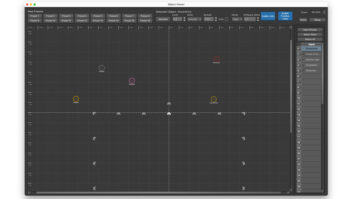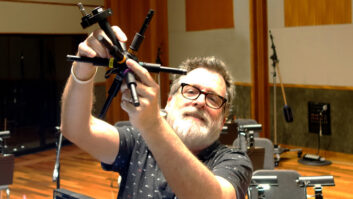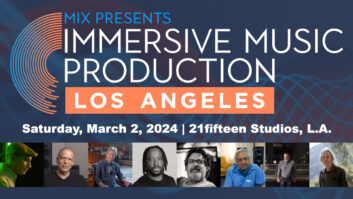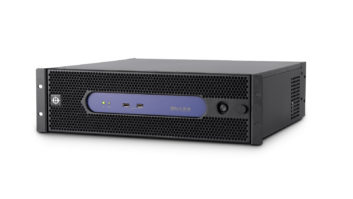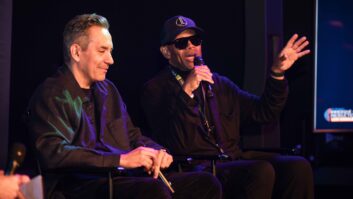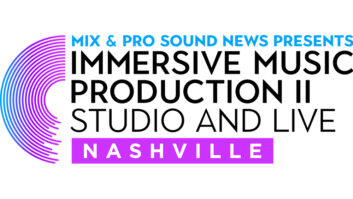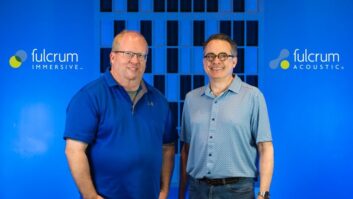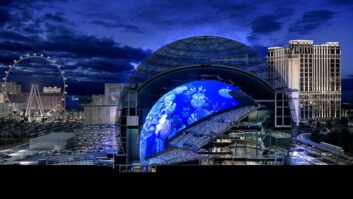
Los Angeles, CA (November 2, 2018)—British band the Tornadoes ushered music fans into the Space Age with “Telstar,” named for the first communications satellite to be launched. Many decades later, Los Angeles electronica duo Test Shot Starfish (TSS) is heralding the new era of interplanetary travel with Music for Space, an album of “thinking man’s techno” that is being mixed for immersive headphone listening with producer Robert Margouleff and partner and collaborator Aaron “Zeus” Zepeda.
“Telstar” topped the charts in 1962, which was also the year that the US exploded a high-altitude nuclear bomb over the Pacific Ocean designated Starfish Prime—from which Kyle Schember and Ryan Stuit took their band’s name. The pair, sound designers and musicians who joined forces in 1999, are working with Margouleff and Zeus to mix the 14-song project, their sophomore release, using Hear360’s immersive audio tools.
Here’s another date: 1971. That’s the year that Margouleff and Malcolm Cecil released the first of two albums by Tonto’s Expanding Head Band, their pioneering synthesizer music ensemble. The project caught the attention of Stevie Wonder, leading to a long, multi-album collaboration that saw the pair awarded engineering Grammys for Innervisions.
“We think of music in terms of architecture,” says Margouleff—meaning, what physical environment, be it a small club, large hall or a church, the music will be played in. “But with electronica, there is no live space. The sound unfolds inside your head. It’s not a report of a real event, of people playing instruments on a stage.”

He continues, “What these guys are doing is what I was doing with Tonto’s Expanding Head Band: creating these marvelous soundscapes. The recording is the performance. All the instruments come from vibrating electrons. There is no more architecture; we have left the real world behind. They’re making music for space travelers.”
In 2005, Schember and Stuit founded Subtractive, an integrated production company; among other things, they produce the music for the webstream of Elon Musk’s SpaceX launches. SpaceX is still six years shy of realizing Musk’s vision of sending the first manned mission to Mars; meanwhile, TSS’s music plays behind the webcast of every Falcon 9 rocket launch.
While technology has been a constraint on music—the capacity of a 78 RPM record led to the three-minute single, for instance—more recent advances have released those shackles. “Some of the information that we couldn’t store in the past was spatial relationships,” says Margouleff, who was in the surround sound vanguard.
In the early ’70s, Margouleff and Cecil worked with designer Tom Hidley to build a custom quadrophonic room for Stevie Wonder at the Record Plant in Hollywood. “People were experimenting with putting quad onto vinyl. I’d put the Fender Rhodes in the back and clavinet in the front, the congas on the left and the rhythm guitar on the right, and Stevie sat in the middle of the room and was immersed in that space. That’s the reason those records sound like that.
“But we couldn’t mix like that. The first mix I ever tried in surround was ‘Superstition.’ It didn’t work. We could record onto four-track, but we couldn’t play it back properly—there was too much crosstalk,” he says.
Years later, Margouleff is revisiting that space. He has evangelized Hear360’s immersive audio products, which have been developed for virtual reality productions. Whereas a TV show or video is viewed in the third person, with the director telling the camera where to look, he says, “VR is an interesting concept, because it’s always in the first person; you’re always looking with your eyes into the scene.”
With that in mind, he says, “I’m starting to mix Test Shot Starfish in headphone surround for VR. It really brings home the whole concept of allowing you to occupy the same space as the music. It’s not the music in front of you, where you’re standing there looking at an event; you’re inside the space. We’re able to take this electronica and truly be able to let it unfold inside your head, so it’s completely immersive. Working with Hear360 and their incredible software, I’ve been able to define a point of view for the music.”
Music for Space can be previewed on the web and was officially released in early October. There are also plans for the immersive mixes to be available on vinyl. “We can put totally spatial, immersive, ambient audio on vinyl. The stylus sees it as stereo, but your headphones control the crosstalk,” Margouleff reports.
“I’ve done it already. I took it over to Warner Bros. a couple of years ago—they thought I was out of my mind. But we’re now at a place where we can bring this to the masses and do it in a really simple way.”
Margouleff has been working on the album with Zeus at their home, mixing alongside Schember and Stuit. “Aaron is a superb musician and understands Ableton and Pro Tools. He and I both perform musically on these tracks; we’re not just the mixer and producer,” he says.
Indeed, that was the original idea behind TONTO—The Original New Timbral Orchestra, a multitimbral polyphonic analog synthesizer comprising components from a multiplicity of manufacturers. “The concept was that other people would come in and play. And, with TONTO, three people would play one instrument,” he says.
“That’s what makes this so very interesting to me. I have returned to where I started with Tonto.”
Test Shot Starfish have embraced the idea that space is the place: “They celebrate the geeks of this world, engineers, creatives, mathematicians, scientists, the people who are really thinking about space travel and Elon’s vision of getting beyond our planet.
“The important things are the intensity, the coloration, the sensibility of the orchestration, the ability to bring a sense of the universe, to leave the planet and write stuff that relates to our quest to be a multi-planetary species. That’s the high purpose of what they are doing.
“It’s another way of thinking about the world and a philosophy of life. This record, for me, encompasses that feeling.”
Hear360 • hear360.io
Test Shot Starfish • www.testshotstarfish.com
